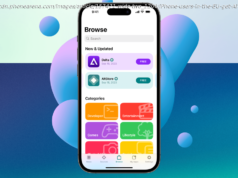The company can now better control its high-flying balloons that aim to blanket remote areas with internet signals. We get a peek inside the Loon lab.
The machinery for Alphabet’s Loon balloons needs to be able to withstand a beating from the elements.
Along the fringes of Google’s Silicon Valley headquarters, in a nondescript, beige-bricked building named « The Rails, » a few guys wearing shark slippers stand in a dark room on a long table that looks like a glowing runway.
They are meticulously examining what look like long, clear trash bags. They’re actually pieces of large balloons, and the workers are scrutinizing them for stress and damage. (The shark slippers are so they don’t damage them further.)
The balloons are the cornerstone of Project Loon, Google’s attempt to connect remote populations to the internet by beaming down Wi-Fi from balloons flying way in the stratosphere. They essentially serve as flying cell towers. On Thursday, the company invited a handful of reporters on a quick tour of the lab where the machinery for the 40-foot-tall balloons is made. (Photos and video recordings were prohibited, though.)
Workers in Google’s forensics lab inspecting the balloons in December.
The scene underscores one simple but obvious thing: Balloons floating through the stratosphere are unpredictable, and anything can happen to them.
Alphabet, Google’s parent company, said it found a way to make the balloons a little less unpredictable. It’s using artificial intelligence to help improve the balloons’ navigation algorithms. That means they can better control a balloon’s ability to loiter in place instead of drifting off.
Now fewer balloons can be clustered around a specific place where people need internet connectivity. So instead of scattering hundreds of balloons across the globe, the company can send 10 to 30 balloons to beam Wi-Fi to a smaller region. Another benefit is they don’t have to waste the technology over oceans, where there aren’t any people.
« We’ve been working to apply more and more machine learning to essentially make the balloons smarter, » Astro Teller, head of X, which handles the company’s ambitious moon shot projects, said after the tour.






